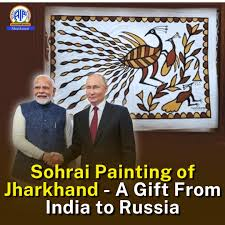PM Modi Showcases India’s Tribal Art at BRICS Summit
Why in the news?
PM Modi highlighted India’s diverse cultural heritage by gifting unique tribal art pieces from Jharkhand and Maharashtra to global leaders during the BRICS summit, promoting India’s traditional crafts globally.
About the Gift of Indigenous Art at BRICS Summit:
- Cultural Exchange:
During the recent BRICS summit in Kazan, Prime Minister Narendra Modi presented Jharkhand’s Sohrai paintings to Russian President Vladimir Putin. This artwork, originating from Hazaribagh district, highlights the indigenous artistic traditions of the region and is recognized as an ODOP (One District One Product). - Sohrai Paintings:
Known for their vibrant use of natural pigments and simple tools, Sohrai paintings are created using brushes made from twigs, rice straw, or even fingers. The intricate designs often depict animals, birds, and nature, reflecting the agrarian lifestyle and the deep respect for wildlife found in tribal cultures. - Other Gifts to BRICS Leaders:
In addition to the gift to President Putin, PM Modi presented other exquisite artworks. To Iranian President Ebrahim Raisi, he gifted a Mother of Pearl SeaShell Vase, showcasing Maharashtra’s coastal craftsmanship. For Uzbekistan’s President, Modi offered a Warli painting, a traditional tribal art form from Maharashtra, characterised by its simplicity and connection to nature. This art dates back to around 3000 BCE, originally created by Warli women to depict their customs and rituals, documenting their lifestyle through visual storytelling.
Sohrai Painting: Overview and Historical Context
- Practice Regions: Predominantly in Jharkhand (Hazaribagh), Bihar, Odisha, and West Bengal.
- Indigenous Communities: Created by women from Kurmi, Santal, Munda, Oraon, Agaria, and Ghatwal tribes.
- Historical Roots: Traces back to Palaeolithic era (7000-4000 BC); resembles ancient animal and floral motifs in Hazaribagh caves.
- Cultural Ties: Linked to the post-Diwali Sohrai festival celebrating harvest, while Khovar relates to weddings and fertility.
Characteristics and Symbolism
- Symbolism: Red lines for ancestors, black for Shiva, white for food and harvest.
- Matriarchal Tradition: Techniques passed from mothers to daughters, emphasising fertility and marital themes.
Preservation Efforts and Recognition
- Recognition: GI tag received in 2020; promoted by Bulu Imam and Sanskriti Museum.
- Government Initiatives: Jharkhand promotes art on trains and public buildings to preserve indigenous heritage.
Sources Referred:
PIB, The Hindu, Indian Express, Hindustan Times





